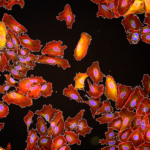Link to Pubmed [PMID] – 15904676
Toxicon 2005 Jun;45(7):807-15
A short peptide derived from the C-terminal region of Bothrops asper myotoxin II, a Lys49 phospholipase A(2) (PLA(2)), was previously found to reproduce the bactericidal activity of its parent molecule. In this study, a panel of eight PLA(2) myotoxins purified from crotalid snake venoms, including both Lys49 and Asp49-type isoforms, were all found to express bactericidal activity, indicating that this may be a common action of the group IIA PLA(2) protein family. A series of 10 synthetic peptide variants, based on the original C-terminal sequence 115-129 of myotoxin II and its triple Tyr–>Trp substituted peptide p115-W3, were characterized. In vitro assays for bactericidal, cytolytic and anti-endotoxic activities of these peptides suggest a general correlation between the number of tryptophan substitutions introduced and microbicidal potency, both against Gram-negative (Salmonella typhimurium) and Gram-positive (Staphylococcus aureus) bacteria. Peptide variants with high bactericidal activity also tended to be more cytolytic towards skeletal muscle C2C12 myoblasts, thus limiting their potential in vivo use. However, the peptide variant pEM-2 (KKWRWWLKALAKK) showed reduced toxicity towards muscle cells, while retaining high bactericidal potency. This peptide also showed the highest endotoxin-neutralizing activity in vitro, and was shown to functionally interact with lipopolysaccharide (LPS) using a chimeric bacteria model. The bactericidal and anti-endotoxic properties of pEM-2, combined with its relatively low toxicity towards eukaryotic cells, highlight it as a promising candidate for further evaluation of its antimicrobial potential in vivo.

